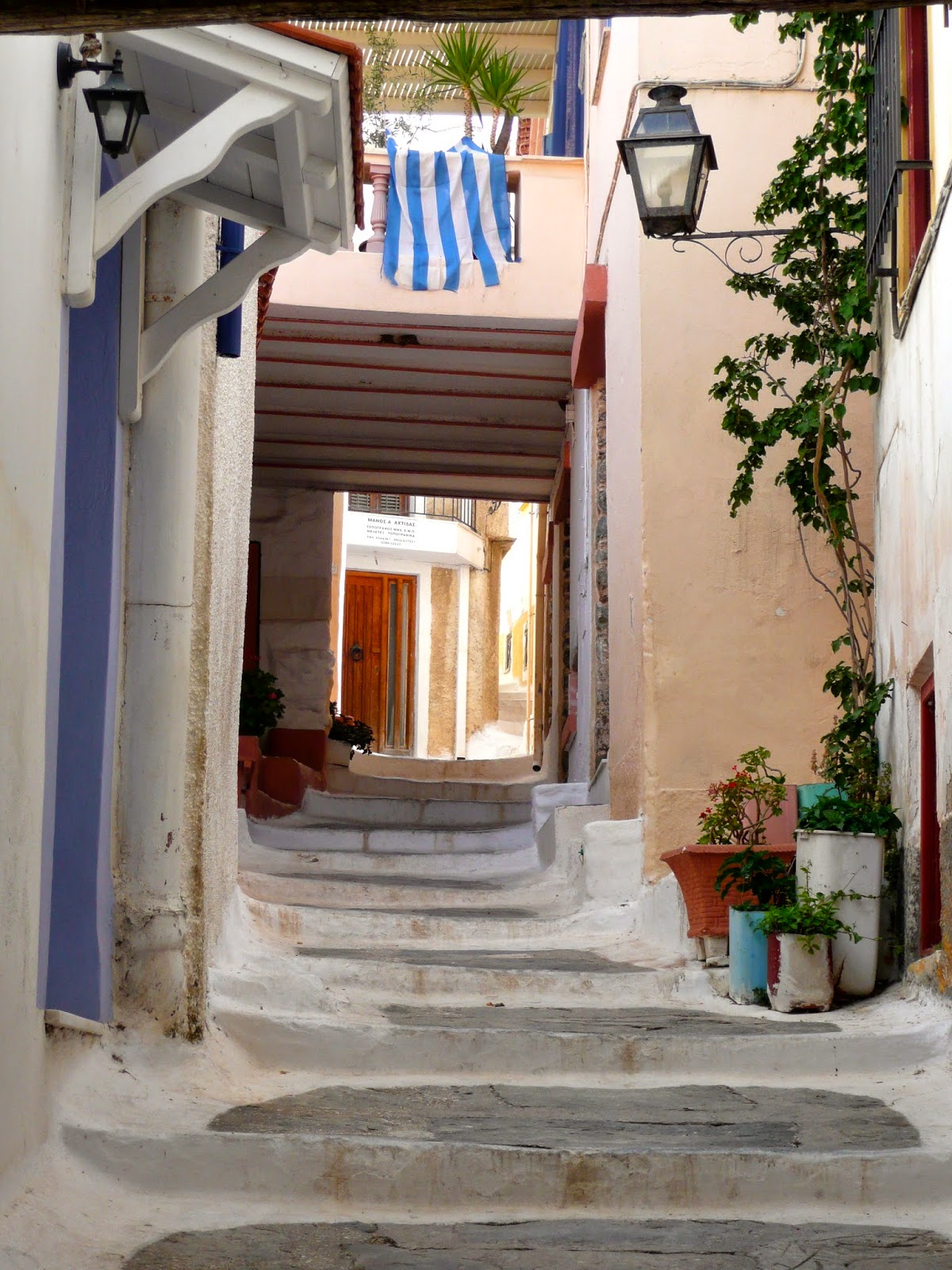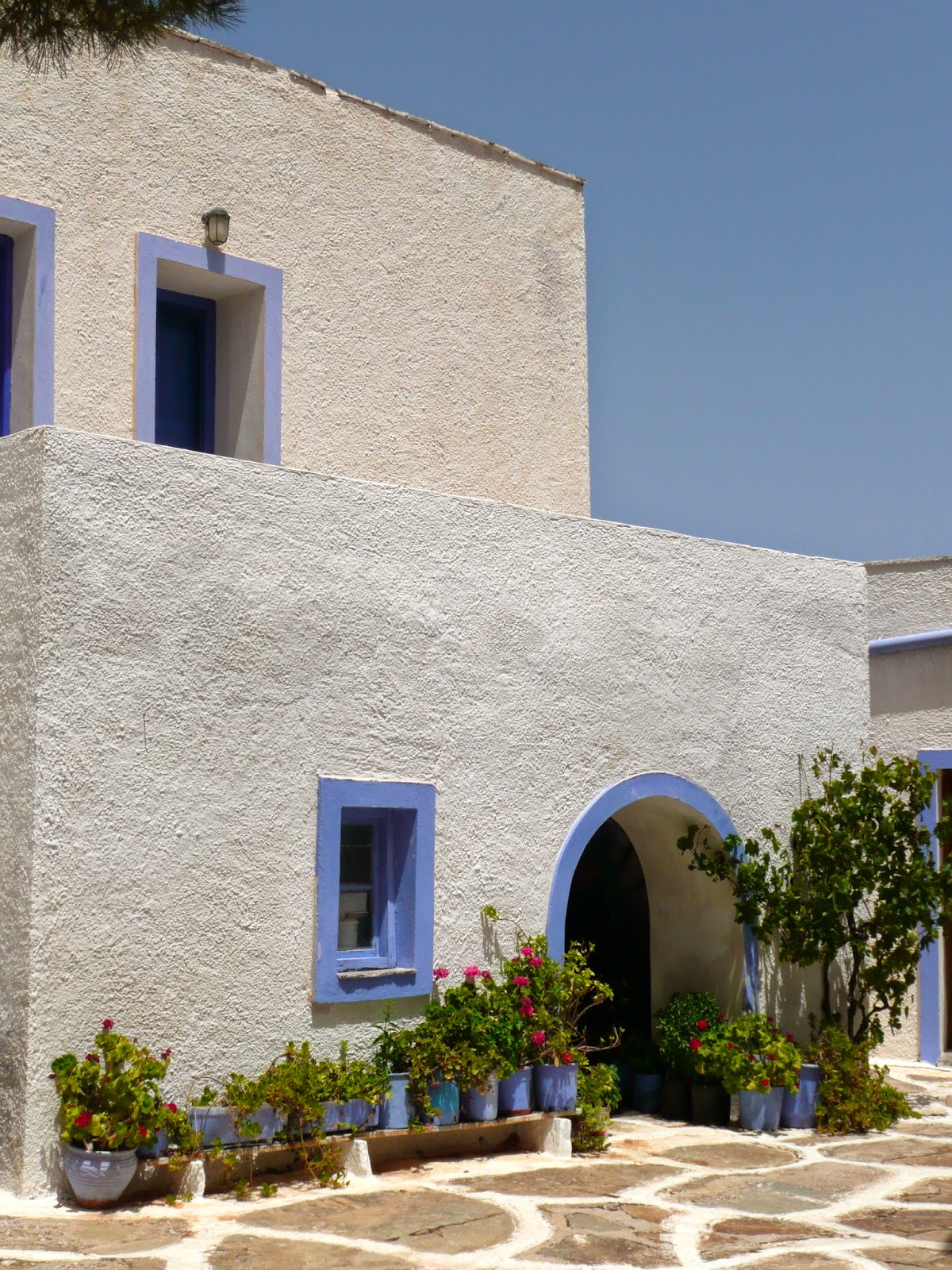Two glorious weeks in southern Greece
Week one was driving around 2/3 of the large peninsula just west of Athens called the Pelopennese. I was with my friend Karen. No tourists, much of it arid mountainous terrain cascading to the aqua marine water.
Week 2 was on a precious island of Kea with Peter. Much the same terrain and always the amazing sea with pocket beaches. Churches on every hill and in every town center.
I have grouped my photos by theme, not chronologically. Enjoy.
Walking through small towns as well as country walks.....
 |
| Island of Spetses |
 |
| Walks to ruins. Drinking lots of water! |
|
 |
| This plant, oleander, is called the highway plant as it is unbelievably hardy but poisonous! | Great color against the hot arid scene. |
 |
| Welcome beaches at the end of the 1 1/2 hour walk! |
Driving the roads was not for the faint of heart but Peter is fearless now!
 |
| The houses on the island of Kea were either stone or white washed cement. Blended well into the surroundings. |
 |
| Light house at the entrance to the island of Kea |
 |
| Looking down from our boutique hotel to the port town of Nafplio |
|
 |
| On the island of Spetses, there is a hero of a woman named Bouboulina. She became a sort of saint, using most of her large inheritance, in the fight to gain independence against the Ottoman rule in the early 1800s. She had a ship built, disguised as a vessel for trading goods when in fact, it was loaded with cannons. Although eventually the Ottomans prevailed. She died when her daughter fell in love with a man whose family didn't approve. They arrived at her house to protest the marriage and shot her dead! |
 |
| Many statues and pictures depict her bravery even when her sailors were cowardly |
|
 |
| There were many small seaside and hillside towns in the Peloponnese built in the 1600s and 1700s. These traditional "tower houses" all have this tower like attachment to see who and what is coming from the sea. The inhabitants of this region were called "Maniots" (direct descendents of the Spartans) and were renowned for their fierce independence, resentment of attempts of others to govern them and for their bitter, spectacularly murderous internal feuds. |
 |
| This was the house of the sea captain, pictured in the photo below. He had his head carved into the entrance to his house. |
|
 |
| Island of Kea - The Port |
 |
| Town Hall in Kea |
|
 |
| At the most southern end of the Peloponnese is the home of Poseidon and this was the Oracle where mystics told your future. |
|
 |
| There are hundreds of kilometers of these cool underground caves. We took a half hour boat trip, marveling at the formations. |
|
The ancient village of Epidavros in the Peloponnese...
 |
| Castles (there are 3) in the city of Nafplio |
 |
| Above and below are 5/6th century BC churches in Mystras, near Sparta. Yes, BC! |
|
Athens is a busy city, plenty of tourists and with the crisis, people on the streets wanting money. The ruins are spectacular. This is the Temple of Zeus below.
 |
| These are parts of the Acropolis. The white is new material while the brown is 25 centuries old! |
|
 |
| The columns get fatter as they go to the ends and spaces between them are not equal. Also, they are made to lean in. This is all to create the illusion of uniformity from a distance. |
 |
| View from the bar at the top of our hotel. |
|
 |
| These women (the Caryatids) were in the building below (Temple of Poseidon) but are now in the museum to preserve them. The ones below are copies. Greece only has 6 of the original 8 as Lord Elgin took the others to England. |
|
 |
| It pays to know your Greek mythological characters when visiting Greece!!! |
|
 |
| So this was a ruin in a Roman Market place. Guess what this is? Toilets in the bath house! |
|
 |
| View at night from our hotel to the Acropolis. |
|
 |
| One day we hiked 2 hours down to the sea and back up to see this amazing sight. It is the Acropolis of Karthaia on the island of Kea. Again, circa 5th 6th century BC. |
Faces of the Greek People
 |
| Every day, on the hour, there is the changing of the "evzones" at the Parliament Building. They use fancy feet and arm movements in perfect unison. I liked to watch the shoe pom poms bounce up and down. |
|
 |
| Before they can take their place in the guard house, they are inspected and then they do the "dance" to get there. |
 |
| Behind is written "In memory of the unknown soldier". |
|
 |
| One of our hotels with very Italian fixtures. Go figure. |
 |
| A "Fix" beer stop in Athens above and watching US soccer game at a taverna below. |
 |
| This man is the unofficial mayor of Hora on the island of Kea. |
 |
| This woman, Aglaia Kremezi, runs a cooking school on Kea. Friends of ours took the 4 day class. One day we were invited to an outrageous lunch. She has produced 6 cook books on Greek and Mediterranean food. She knows her stuff! | |
 |
| This dish was a kid goat in the morning, slaughtered, rubbed with stuff, piled high with herbs and put in an outdoor clay oven for hours. Yummy! |
 |
| You might be wondering why this photo. We stayed at an eco hotel (Red Tractor Inn) on Kea. Our host, Marcie is dedicated to reviving the once thriving use of their acorns. There are tons of acorn trees but 70 years ago, the cultivation stopped. You can see by making a comparison to a lemon that their acorns are bigger than Vermont's. The caps are not as smooth. |
 |
| The tops are used to make leather after a tanning process. |
 |
| The nut is ground to make, among other things, acorn flour (turned into gourmet cookies in her kitchen). |
Now the churches.... Some have 3 or 5 bell openings, some are basic, some simple island churches and those that are new.
In conclusion, below is an ideal Greek lunch, and sunset on our final day!
































































































No comments:
Post a Comment